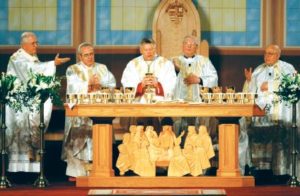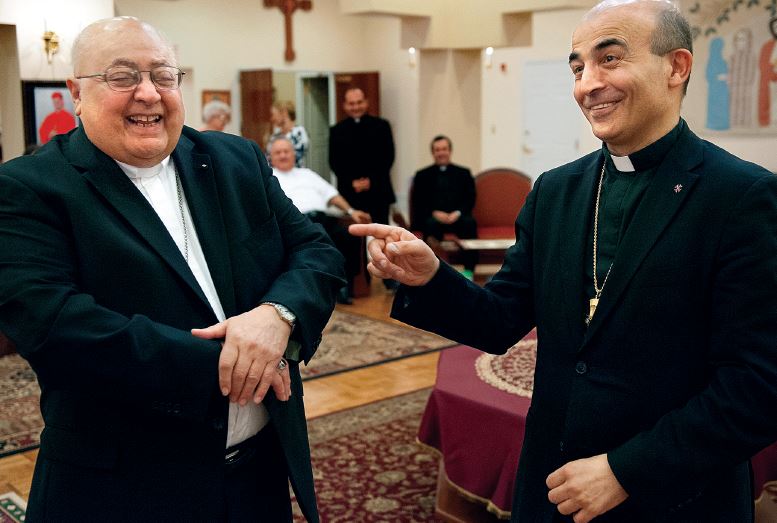By Jennifer Brinker / St. Louis Review
ST. LOUIS — Bishop Robert J. Shaheen, the first Maronite priest to be ordained in the United States and a priest and bishop in St. Louis for a half-century, died Aug. 9. Bishop Shaheen, who celebrated his 80th birthday in June, was the second bishop of the Eparchy of Our Lady of Lebanon of Los Angeles, headquartered in St. Louis. He retired in 2013.
A celebration of the Divine Liturgy (funeral) was held Aug. 16 at St. Raymond Maronite Cathedral in St. Louis. He was buried Aug. 21 from St. Anthony Maronite Church in his hometown of Danbury, Conn.
“We pray for the repose of his soul and give thanks to God for all of the lives that Bishop Shaheen has touched in his extraordinary life,” said Bishop A. Elias Zaidan, current bishop and successor to Bishop Shaheen.
“I am saddened to hear of the passing of Bishop Robert J. Shaheen, a good friend and a beloved shepherd of the Maronite Catholic community,” Archbishop Robert J. Carlson of St. Louis stated. “I ask that the faithful of the Archdiocese of St. Louis join me in praying for the repose of the soul of Bishop Shaheen. Bishop Elias Zaidan and the faithful of the Eparchy of Our Lady of Lebanon of Los Angeles will continue to be in our thoughts and prayers. May his soul, and the souls of all the faithful departed, rest in peace.”
Born to Albert and Aileen Shaheen in Danbury, he attended St. Peter Grammar School and Danbury High School before entering the Latin Church St. Thomas Seminary in Bloomfield in 1955. In 1958, he transferred to the Eastern-rite St. Basil Seminary in Methuen, Mass., while attending classes at St. Anselm College in Goffstown, N.H.
After being ordained a subdeacon (Oct. 2, 1962) and deacon (June 7, 1963), Bishop Shaheen was ordained a priest by Bishop Francis Mansour Zayek on May 2, 1964, at the Basilica of the National Shrine of the Immaculate Conception. Shortly after his ordination, he became pastor of St. Raymond’s Church in St. Louis, which had been without a resident priest for more than 20 years. Under his leadership, St. Raymond’s went from just a few faithful parishioners using a four-family apartment to a cathedral with hundreds of active families.
Between 1965 and 1970, he organized and celebrated Maronite liturgies on a regular basis. He also: developed newsletters, bulletins, and fliers; conducted a census to identify Maronites in the greater metropolitan area; and introduced spiritual and cultural programs, including Maronite religious education classes. He hosted the National Apostolate of Maronites Convention in 1970. Kicking off a fund drive for a new church in 1971, he later dedicated the new church in November 1975 and a new rectory in February 1977.
He was ordained an archpriest in September 1978 and dedicated a new parish center, The Cedars, in November 1979.
In 1986, Bishop Shaheen was ordained a chorbishop by Archbishop Zayek. He purchased additional property and buildings for future development as a Maronite retirement center and cultural center in 1991 and again hosted the National Apostolate of Maronites Convention in 1995.
On Dec. 5, 2000, Bishop Shaheen was appointed eparch of the Eparchy of Our Lady of Lebanon by Pope St. John Paul II, following the retirement of Our Lady of Lebanon’s first bishop, John George Chedid. He was consecrated a bishop on Feb. 15, 2001, by Nasrallah Boutros Sfeir, the patriarch of Antioch and All the East, at the Cathedral Basilica of St. Louis.
Bishop Shaheen retired in 2013. Bishop Zaidan succeeded him as the third bishop of the Eparchy of Our Lady of Lebanon of Los Angeles.
Bishop Shaheen was known for revitalizing the LaSalle Park neighborhood on the near southside of St. Louis, where the cathedral is located. He led the parish through a large capital program, including the construction of a new church, rectory, hall, and eparchal center, over the years of his pastoral ministry.
He also had a longstanding interest and concern for the wellbeing of Christians in the Middle East during the Syrian conflict. Lebanon, in particular, has been heralded as an example of peace in the Middle East, he said prior to a 2013 visit to Lebanon. “Lebanon has always been a country that has accepted all sorts of persecuted people,” he said. “It’s a place where Christians and Muslims live together with no difficulty. They go to the same schools, live in the same villages. Even today, as a Maronite Catholic bishop, I could go into a Muslim (owned) restaurant and I would receive a warm welcome. Lebanon has always had that idea of tolerance, of equality.”

Bishop Richard F. Stika celebrates Mass at his episcopal ordination in 2009. Concelebrating
was Bishop Robert J. Shaheen, right, as well as Cardinal Justin Rigali, Archbishop Joseph E. Kurtz, and Papal Nuncio Archbishop Pietro Sambi.
Bishop Richard F. Stika of the Diocese of Knoxville was a close friend of Bishop Shaheen, who was the first person to whom Bishop Stika went when he decided he wanted to become a priest. As a young seminarian, Bishop Stika worked at St. Raymond while he was studying at Kenrick Seminary. Then-Father Shaheen took him under his wing, having him assist at liturgies. When Bishop Stika was ordained a priest in 1985, Bishop Shaheen preached at his first Mass. He later was a co-consecrator at Bishop Stika’s episcopal ordination in 2009 in Knoxville. Even though he became an archdiocesan priest, Bishop Stika has faculties in both the Latin and Maronite rites.
Bishop Stika said he ran into his old friend while attending the Knights of Columbus annual Convention in St. Louis in early August. That was the last time the bishops would see each other. “He said, ‘Why don’t you come for lunch?’” Bishop Stika said. “We sat there for about two hours, we told stories, and I made fun of him like I always did — I was one of the few who could get away with that.”
During their visit, he showed Bishop Shaheen construction pictures of the Diocese of Knoxville’s new Cathedral of the Most Sacred Heart of Jesus, which will be dedicated in March. Among the saints represented in the cathedral’s dome is St. Charbel, a Maronite monk from Lebanon — a tribute to Bishop Stika’s Maronite connection.
Life at St. Raymond’s without Bishop Robert Shaheen — a fixture at the Maronite cathedral for half a century — is going to be difficult for parishioners, friends, and family.
“Bishop Shaheen has been so much a part of that parish for 50 years, it’s going to be hard to comprehend going to visit there and not see him — he was St. Raymond’s,” Bishop Stika said.
At the end of their visit, as always, the two hugged. Bishop Shaheen gave Bishop Stika his customary kiss on the cheek, telling Bishop Stika how proud he was of him.
“I told him, ‘I’m coming back in September, so I’ll see you then,’” Bishop Stika recalled. “I guess now I’ll see him in heaven someday.”

